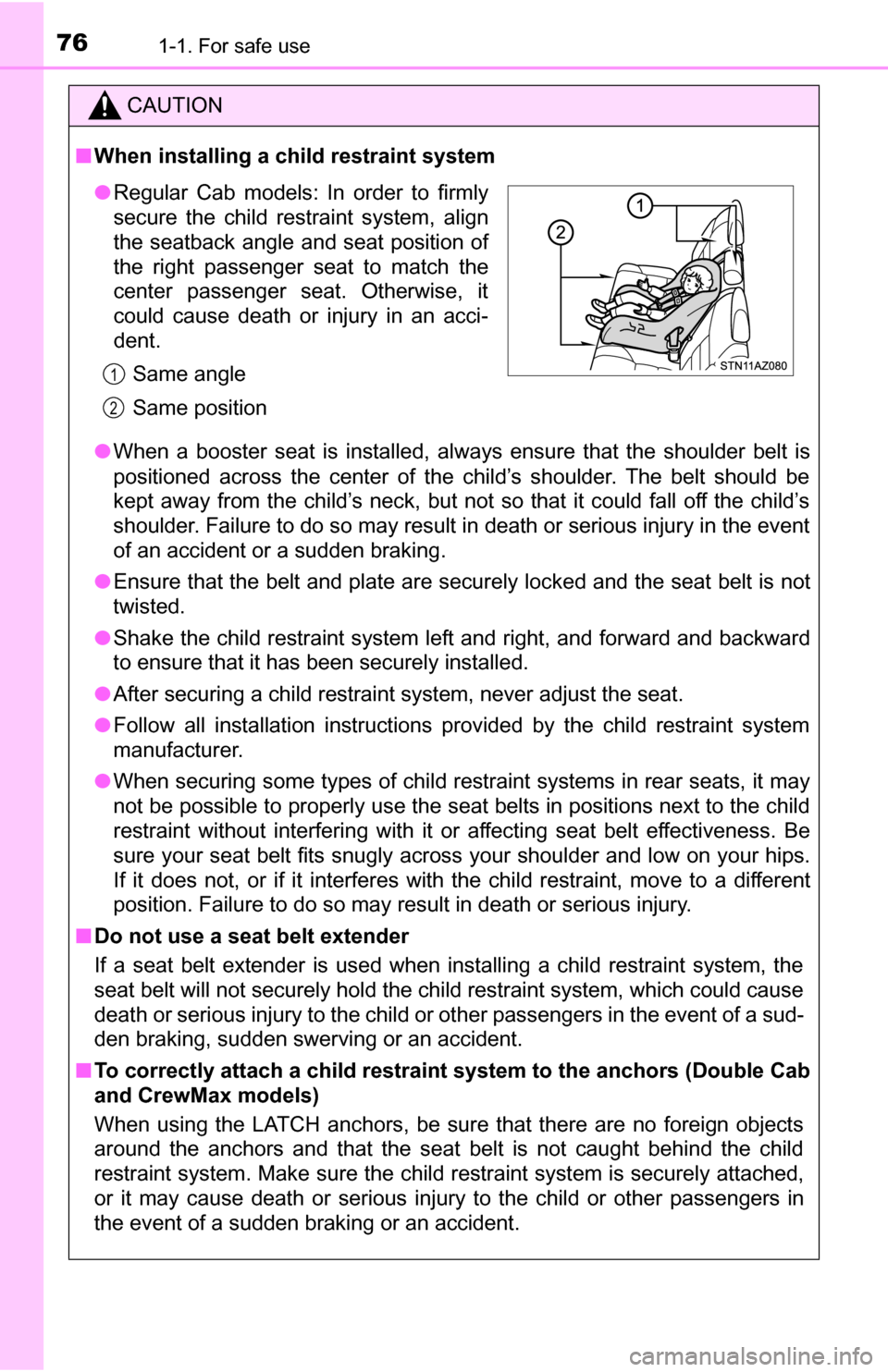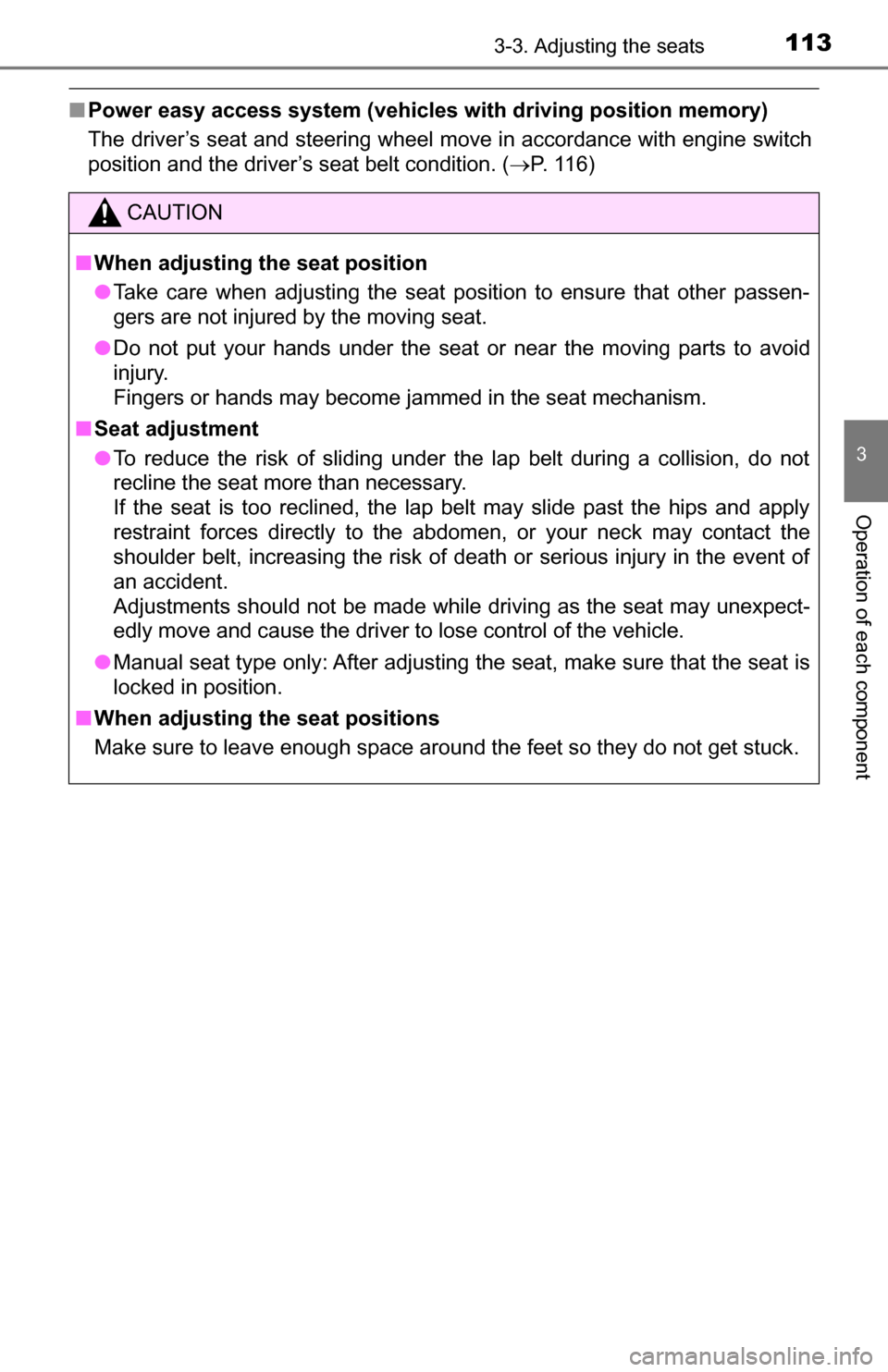Page 74 of 588
741-1. For safe use
■Left seat
Secure the child restraint system using a seat belt or the lower
anchors.
Remove the head restraints of
the center and left rear seats.
( P. 121)
Route the top tether strap
through the anchor strap belt as
shown in the illustration.
Make sure the top tether strap is
not twisted.
Anchor strap belt
Latch the hook onto the anchor
strap belt and tighten the top
tether strap.
Make sure the top tether strap is
securely latched.
Anchor strap belt
Replace the head restraints of
center and left rear seats.
( P. 122)
1
2
3
1
4
1
5
Page 76 of 588

761-1. For safe use
CAUTION
■When installing a child restraint system
● When a booster seat is installed, always ensure that the shoulder belt is
positioned across the center of the child’s shoulder. The belt should be
kept away from the child’s neck, but not so that it could fall off the child’s
shoulder. Failure to do so may result in death or serious injury in the event
of an accident or a sudden braking.
● Ensure that the belt and plate are securely locked and the seat belt is not
twisted.
● Shake the child restraint system left and right, and forward and backward
to ensure that it has been securely installed.
● After securing a child restraint system, never adjust the seat.
● Follow all installation instructions provided by the child restraint system
manufacturer.
● When securing some types of child restraint systems in rear seats, it may
not be possible to properly use the seat belts in positions next to the child
restraint without interfering with it or affecting seat belt effectiveness. Be
sure your seat belt fits snugly across your shoulder and low on your hips.
If it does not, or if it interferes with the child restraint, move to a different
position. Failure to do so may result in death or serious injury.
■ Do not use a seat belt extender
If a seat belt extender is used when installing a child restraint system, the
seat belt will not securely hold the child restraint system, which could cause
death or serious injury to the child or other passengers in the event of a sud-
den braking, sudden swerving or an accident.
■ To correctly attach a child restrain t system to the anchors (Double Cab
and CrewMax models)
When using the LATCH anchors, be sure that there are no foreign objects
around the anchors and that the seat belt is not caught behind the child
restraint system. Make sure the child restraint system is securely attached,
or it may cause death or serious injury to the child or other passengers in
the event of a sudden braking or an accident.
● Regular Cab models: In order to firmly
secure the child restraint system, align
the seatback angle and seat position of
the right passenger seat to match the
center passenger seat. Otherwise, it
could cause death or injury in an acci-
dent.
Same angle
Same position
1
2
Page 97 of 588
97
3
Operation of
each component
3-1. Key information
Keys .................................... 98
3-2. Opening, closing and locking the doors
Side doors ......................... 100
Tailgate ............................. 106
3-3. Adjusting the seats Front seats ........................ 111
Rear seats (Double Cab and CrewMax
models) ........................... 114
Driving position memory (driver’s seat) .................. 116
Head restraints .................. 120
3-4. Adjusting the steering wheel and mirrors
Steering wheel .................. 124
Inside rear view mirror....... 127
Outside rear view mirrors ............................. 130 3-5. Opening, closing the
windows and moon roof
Power windows ................. 134
Back window ..................... 137
Power back window .......... 138
Moon roof .......................... 141
Page 105 of 588
1053-2. Opening, closing and locking the doors
3
Operation of each component
■Customization that can be configured at Toyota dealer
Settings (e.g. unlocking function using a key) can be changed.
(Customizable features: P. 543)
CAUTION
■ To prevent an accident
Observe the following precautions while driving the vehicle.
Failure to do so may result in a door opening and an occupant throwing out
of the vehicle, resulting in death or serious injury.
● Ensure that all doors are properly closed and locked.
● Do not pull the inside handle of the doors while driving.
Be especially careful for the front doors, as the doors may be opened even
if the inside lock buttons are in locked position.
● Double Cab and CrewMax models: Set the rear door child-protector locks
when children are seated in the rear seats.
Page 111 of 588
1113-3. Adjusting the seats
3
Operation of each component
Front seats
■Driver’s seat
■Passenger’s seat
Manual seat
Adjustment procedure (separated type seats)
Seat position adjustment
switch
Seatback angle adjustment
switch
Seat cushion length adjust-
ment switch (if equipped)Seat cushion (front) angle
adjustment switch
Seat vertical height adjust-
ment switch
Seat lumbar support adjust-
ment switch1
2
3
4
5
6
Seat position adjust
ment lever Seatback angle adjustment
lever12
Page 112 of 588
1123-3. Adjusting the seats
Power seat
Seat position adjustment
switch
Seatback angle adjustment
switchSeat lumbar support adjust-
ment switch
Adjustment procedure (bench type seats)
1
2
3
Seat position adjustment
levers
Seatback angle adjustment
leversCenter seat seatback angle
adjustment lever1
2
3
Page 113 of 588

1133-3. Adjusting the seats
3
Operation of each component
■Power easy access system (vehicles with driving position memory)
The driver’s seat and steering wheel move in accordance with engine switch
position and the driver’s seat belt condition. ( P. 116)
CAUTION
■ When adjusting the seat position
● Take care when adjusting the seat position to ensure that other passen-
gers are not injured by the moving seat.
● Do not put your hands under the seat or near the moving parts to avoid
injury.
Fingers or hands may become jammed in the seat mechanism.
■ Seat adjustment
● To reduce the risk of sliding under the lap belt during a collision, do not
recline the seat more than necessary.
If the seat is too reclined, the lap belt may slide past the hips and apply
restraint forces directly to the abdomen, or your neck may contact the
shoulder belt, increasing the risk of death or serious injury in the event of
an accident.
Adjustments should not be made while driving as the seat may unexpect-
edly move and cause the driver to lose control of the vehicle.
● Manual seat type only: After adjusting the seat, make sure that the seat is
locked in position.
■ When adjusting the seat positions
Make sure to leave enough space around the feet so they do not get stuck.
Page 114 of 588
1143-3. Adjusting the seats
Rear seats (Double Cab and CrewMax mod-
els)
Use the seat belt hangers to
prevent the belts from being
tangled.
Pull and release the lever to
unlock while raising the bottom
cushion until it locks.
When returning the bottom
cushion to its original position,
pull and release the lever, then
carefully lower the bottom cush-
ion using your other hand.
Raising the bottom cushion
1
2